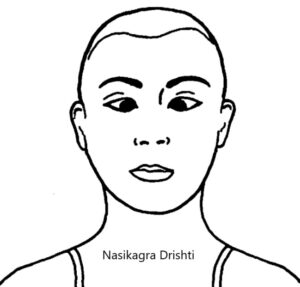Nasikagra Mudra
Introduction
Nasikagra Mudra is a classical yogic hand-and-eye gesture primarily used during Pranayama (breathing practices). The word comes from Sanskrit: Nasika = nose, Agra = tip, and Mudra = seal/gesture. It involves using the right hand in Vishnu Mudra (or Nasikagra Mudra) to regulate alternate nostril breathing (Nadi Shodhana).
It is both a hand mudra (gesture of the fingers for nostril control) and an eye mudra (fixing gaze at the nose tip). This mudra is a powerful tool for balancing the breath, calming the mind, and harmonizing the flow of prana.
Meaning
Nasikagra Mudra (Hand aspect): Gesture used in pranayama to alternately close nostrils.
Nasikagra Drishti (Eye aspect): Concentration at the tip of the nose, a form of Trataka (yogic gazing) used in meditation.
It symbolizes focused attention, control of prana, and one-pointed concentration (ekagrata).
How to Perform Practice
Step-by-step (Hand Position in Pranayama)
Sit in a comfortable meditative posture (Padmasana, Siddhasana, or Vajrasana).
Keep the spine and head upright. Relax the body.
Close the eyes and relax the whole body. Relax all the muscles of the face, including the forehead, the eyes and behind the eyes.
Slowly open the eyes and look ahead at a fixed point, keeping the head and the whole body absolutely still. Next, look upward and inward, focusing the eyes at the eyebrow centre.
The head should not move. When performed correctly, the curve of the eyebrows will form a V-shaped image.
The apex of the V is located at the eyebrow centre. If the V-formation is not seen, the gaze is not directed upward and inward correctly Release the gaze at the slightest sensation of strain.
Hold the gaze for only a few seconds at first. Close the eyes and relax them. Suspend the thought processes and meditate on the stillness in the dark space in front of the closed eyes.
Benefits
Physical Benefits
Facilitates alternate nostril breathing smoothly.
Improves respiratory efficiency.
Relieves nasal congestion and enhances oxygen intake.
Strengthens facial, nasal, and hand muscles.
Mental & Emotional Benefits
Induces calmness and focus.
Reduces stress, anxiety, and mental agitation.
Enhances concentration and willpower.
Promotes balance between logic and intuition.
Spiritual Benefits
Balances ida and pingala nadis → awakens Sushumna.
Prepares the mind for meditation and dharana.
Activates the Ajna Chakra (when combined with Nasikagra Drishti).
Leads to inner stillness and one-pointed awareness.
Contraindications
Should not be practiced with severe cold, nasal blockages, or sinus infection.
Avoid if suffering from asthma attack or severe respiratory disorder.
People with severe migraines, glaucoma, or eye strain should not attempt Nasikagra Drishti for long durations.
Should be avoided immediately after heavy meals.
Anatomy & Physiology
Engages finger flexors/extensors for nostril control.
Stimulates nasal passages and lungs, aiding respiration.
Influences the autonomic nervous system, balancing sympathetic (right nostril) and parasympathetic (left nostril) functions.
Helps regulate heart rate, blood pressure, and oxygen-CO₂ exchange.
Kinesiology
Thumb movement: Adduction/flexion to close the right nostril.
Ring & little finger movement: Flexion to close the left nostril.
Forearm muscles (flexor digitorum profundus, flexor pollicis longus) stabilize finger action.
Chest muscles expand/contract rhythmically with breathing cycles.
Neurology
Stimulates olfactory nerves and nasal reflex pathways.
Enhances vagus nerve activity, inducing relaxation.
Activates prefrontal cortex (attention, self-regulation).
Balances left and right brain hemispheres via alternate nostril breathing.
Duration of Mudra
During pranayama: 5–20 minutes depending on practice.
Daily practice: 10–15 rounds of alternate nostril breathing with Nasikagra Mudra.
Nasikagra Drishti: 1–3 minutes initially, gradually extending to 5 minutes.
Counter Mudra
Chin Mudra / Jnana Mudra → for meditation after pranayama.
Prana Mudra → to energize after deep breath regulation.
Nasagra Drishti (with Shambhavi Mudra) → as an alternate focusing practice.
Conclusion
Nasikagra Mudra is a fundamental yogic hand gesture essential in pranayama. It is not just a physical aid but a symbolic gesture of discipline, focus, and pranic regulation. When combined with Nasikagra Drishti, it helps unite breath, body, and mind, leading to higher awareness. Its consistent practice refines the nervous system, balances energy channels, and prepares the practitioner for deep meditation.
FAQ
Q1: Is Nasikagra Mudra the same as Vishnu Mudra?
Yes, both refer to the same hand gesture used in pranayama.
Q2: Can beginners practice it daily?
Yes, it is safe for beginners, especially with simple Anulom Vilom.
Q3: Does it cure sinus problems?
It helps improve nasal airflow but is not a cure. It supports healing when combined with lifestyle practices.
Q4: Is Nasikagra Drishti safe for the eyes?
Yes, if done briefly. Avoid long practice if you have eye strain or pressure issues.
Q5: Which pranayamas use this mudra?
Mainly Nadi Shodhana, Anulom Vilom, Surya Bhedi, Chandra Bhedi, and Bhramari Pranayama.
References
Swami Satyananda Saraswati – Asana, Pranayama, Mudra, Bandha
B.K.S. Iyengar – Light on Pranayama
Dr. Hiroshi Motoyama – Theories of the Chakras
Indu Arora – Mudra: The Sacred Secret
Bihar School of Yoga – Yoga Publications
